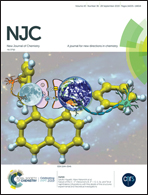A benzofuran-β-alaninamide based “turn-on” fluorescent chemosensor for selective recognition of Fe3+ ions†
Abstract
A benzofuran-β-alaninamide based chemosensor, 3-(3-((4-methylbenzyl)amino)propanamido)benzofuran-2-carboxamide (BAA), was designed and synthesized for selective detection of Fe3+ ions. The binding ability of BAA towards Fe3+ in DMSO/H2O solution (9/1, v/v) has been studied by UV-vis absorption and fluorescence spectroscopy. Interestingly, the probe BAA exhibits an excellent “turn-on” fluorescence enhancement at 424 nm with an excitation wavelength of 290 nm. The quantum yield was determined to be 0.248 for BAA and 0.447 for the iron complex. The limit of detection (LOD) was calculated to be 1.3 μM and 0.067 μM by UV-vis absorption and fluorescence methods respectively. These values are much lower than that of US Environmental Protection Agency guidelines for drinking water (5.37 μM). Job's plot measurement evidenced the 2 : 1 binding stoichiometry for the complex formed between BAA and Fe3+. Moreover, the binding interaction of BAA towards Fe3+ was confirmed by density functional theory (DFT) studies. Finally, the real sample analysis proved that the probe BAA was more suitable for the detection of Fe3+.



 Please wait while we load your content...
Please wait while we load your content...